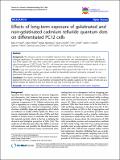Effects of long-term exposure of gelatinated and non-gelatinated cadmium telluride quantum dots on differentiated PC12 cells
Date
2012-01-20Author
Prasad, Babu R.
Mullins, Gillian
Nikolskaya, Natalia
Connolly, David
Smith, Terry
Rochev, Yury
Metadata
Show full item recordUsage
This item's downloads: 308 (view details)
Cited 23 times in Scopus (view citations)
Recommended Citation
Prasad, BR,Mullins, G,Nikolskaya, N,Connolly, D,Smith, TJ,Gerard, VA,Byrne, SJ,Davies, GL,Gun'ko, YK,Rochev, Y (2012) 'Effects of long-term exposure of gelatinated and non-gelatinated cadmium telluride quantum dots on differentiated PC12 cells'. Journal Of Nanobiotechnology, 10 (4).
Published Version
Abstract
Background: The inherent toxicity of unmodified Quantum Dots (QDs) is a major hindrance to their use in biological applications. To make them more potent as neuroprosthetic and neurotherapeutic agents, thioglycolic acid (TGA) capped CdTe QDs, were coated with a gelatine layer and investigated in this study with differentiated pheochromocytoma 12 (PC12) cells. The QD - cell interactions were investigated after incubation periods of up to 17 days by MTT and APOTOX-Glo Triplex assays along with using confocal microscopy.Results: Long term exposure (up to 17 days) to gelatinated TGA-capped CdTe QDs of PC12 cells in the course of differentiation and after neurites were grown resulted in dramatically reduced cytotoxicity compared to non-gelatinated TGA-capped CdTe QDs.Conclusion: The toxicity mechanism of QDs was identified as caspase-mediated apoptosis as a result of cadmium leaking from the core of QDs. It was therefore concluded that the gelatine capping on the surface of QDs acts as a barrier towards the leaking of toxic ions from the core QDs in the long term (up to 17 days).
Description
Journal article (open access)


